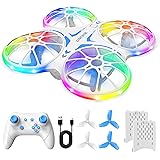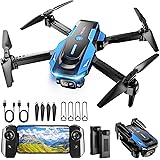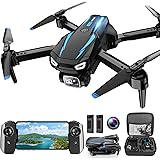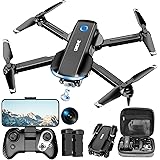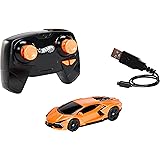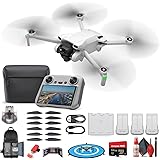The allure of extended flight, pushing beyond the conventional limits of multicopters, resonates deeply within the drone community. When enthusiasts envision aerial platforms capable of traversing significant distances with efficiency, the conversation often turns to specialized designs. The video above, showcasing a long-range tricopter, provides a glimpse into the mechanics of such a marvel. While silent in its presentation, the visual dynamics and the very concept of a long-range tricopter speak volumes about its sophisticated engineering and the dedicated pursuit of endurance in flight.
A long-range tricopter is more than just a drone; it is a finely tuned instrument, a ballet of physics and electronics designed for sustained aerial operations. Unlike its quadcopter counterparts, the tricopter configuration introduces unique challenges and advantages, particularly concerning yaw control and aerodynamic efficiency. Achieving impressive flight times and distances demands a holistic approach, scrutinizing every component from prop tip to battery cell.
Engineering Endurance: The Core of a Long-Range Tricopter
Building a long-range tricopter involves a complex interplay of design choices, where every gram and every watt-hour is scrutinized. The goal is to maximize flight efficiency, akin to an albatross effortlessly gliding across oceans, using minimal energy for vast distances. This isn’t merely about strapping on a bigger battery; it’s about optimizing the entire system.
Aerodynamic Efficiency and Propeller Selection
The fuselage of a long-range tricopter must cut through the air with minimal resistance. A sleek, low-drag profile is paramount, much like a spear through water. Blocky components or poorly routed wires can drastically increase drag, consuming valuable battery power. Furthermore, propeller choice is a critical determinant of efficiency. Larger, slower-spinning propellers, often with a higher pitch, are typically favored for endurance. They operate in a more efficient thrust regime, moving more air at a lower RPM, similar to how a large ship’s propeller moves vast amounts of water slowly but powerfully.
Consider the trade-off: a smaller, faster prop generates agility, ideal for racing. However, for a long-range mission, the focus shifts to maximizing lift per unit of power. Therefore, propeller materials, blade count, and even tip design play pivotal roles in converting electrical energy into effective thrust.
Power Systems: Batteries, Motors, and ESCs
At the heart of any long-range tricopter lies its power system. Lithium-ion (Li-ion) batteries are often preferred over Lithium-polymer (LiPo) for their higher energy density, providing more watt-hours per gram, although they typically have lower discharge rates. It’s a fundamental comparison: LiPo is the sprinters’ fuel, while Li-ion is the marathon runners’ steady supply.
Motor selection is equally critical. Low Kv (RPM per Volt) motors paired with the larger propellers mentioned earlier are standard. These motors are designed to operate efficiently at lower RPMs, pulling less current while still generating sufficient thrust. Electronic Speed Controllers (ESCs) must be chosen not only for their current handling capabilities but also for their efficiency. Modern ESC firmware, such as BLHeli_32 or AM32, offers advanced timing and commutation options that can extract marginal but significant efficiency gains. Heat generation in ESCs is a direct indicator of wasted energy; cooler running ESCs are often more efficient.
Flight Control and Radio Link Integrity
A stable and reliable flight controller is the brain of the long-range tricopter. Open-source firmwares like ArduPilot or iNav are often chosen for their extensive feature sets, including advanced navigation, mission planning, and failsafe protocols. GPS modules are indispensable for accurate positioning and return-to-home functionalities, acting as the tricopter’s navigational compass.
For long-range applications, the radio link is not just a command channel; it is the lifeline. Traditional 2.4 GHz radio systems quickly reach their limits. Long-range control links, such as those operating on 900 MHz or 433 MHz (e.g., Crossfire, ELRS, Tracer), offer significantly greater range and penetration capabilities, critical for maintaining command beyond line of sight. These systems often employ frequency hopping spread spectrum (FHSS) or other robust modulation techniques to resist interference, much like a sophisticated encrypted message ensuring its delivery regardless of noise.
Structural Integrity and Weight Optimization
The frame of a long-range tricopter must strike a delicate balance between strength, rigidity, and minimal weight. Carbon fiber is the material of choice due to its exceptional strength-to-weight ratio. The design should minimize unnecessary material, resembling the optimized skeletal structure of a bird.
Furthermore, proper weight distribution is crucial. Components should be placed to ensure the center of gravity (CG) aligns perfectly with the center of lift. An imbalanced tricopter works harder to stay level, leading to increased power consumption and reduced endurance. Vibration isolation for the flight controller and other sensitive electronics is also vital, preventing sensor noise that can destabilize flight and consume additional energy in corrections.
Payloads and Telemetry
While the primary goal is range, many long-range tricopters carry payloads, often for aerial photography, surveying, or delivery. Integrating these payloads seamlessly without compromising efficiency is another engineering feat. Light-weight cameras, gimbal systems, or specialized sensors add to the overall weight, necessitating further optimization of the propulsion system. Every additional gram must justify its presence.
Telemetry, the real-time data stream from the tricopter to the ground station, is invaluable for long-range flights. It provides critical information on battery voltage, current draw, GPS coordinates, altitude, and signal strength. This data allows pilots to make informed decisions about flight path adjustments, return timing, and emergency procedures, offering situational awareness akin to an aircraft’s cockpit dashboard.
Advanced Considerations and Operational Practice
Operating a long-range tricopter successfully involves more than just hardware. Environmental factors, flight planning, and regulatory compliance are equally important.
Environmental Factors
Wind is the nemesis of long-range flight. Flying into a strong headwind drastically reduces range, whereas a tailwind can extend it. Pilots must monitor weather conditions meticulously, anticipating gusts and planning routes that minimize energy expenditure. Temperature also affects battery performance; cold weather reduces effective capacity, a critical factor for endurance missions.
Flight Planning and Execution
Comprehensive mission planning is essential. This includes pre-calculating the required energy for the intended route, factoring in reserve power for unexpected events or return-to-home procedures. Utilizing ground station software for waypoint navigation and automated flight paths allows for precise, repeatable missions. Just as a ship captain plots a course, a tricopter pilot meticulously plans the aerial journey.
Pilots must also be proficient in manual flight control for emergencies and nuanced maneuvers. Even with advanced automation, human intervention might be necessary to navigate unforeseen obstacles or respond to system anomalies. Mastery of both automated and manual flight ensures mission success and safety for any long-range tricopter operation.


